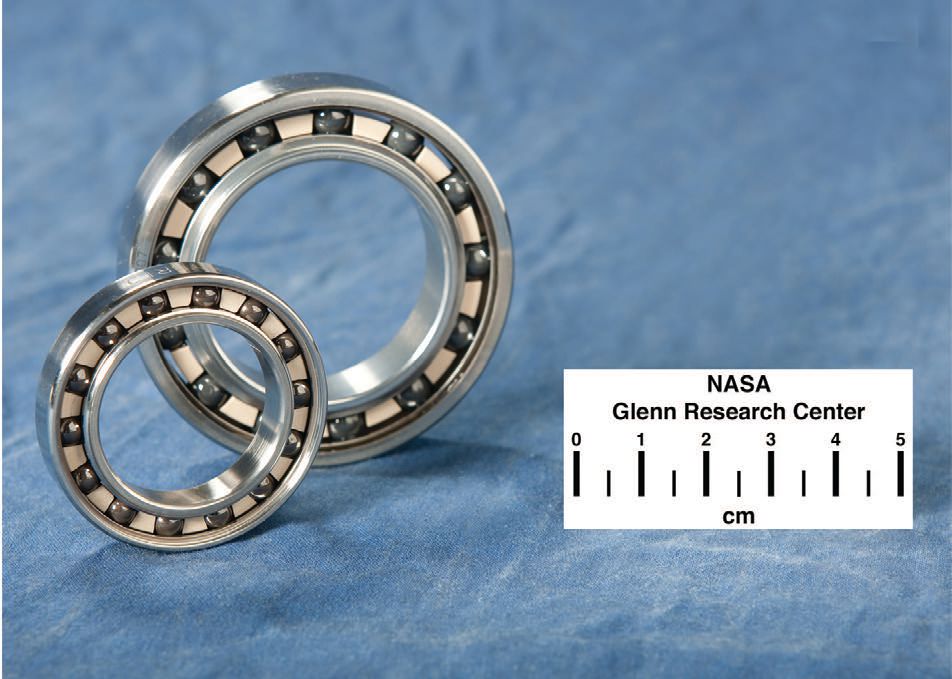Corrosion-proof nickel titanium bearings
Dr. Neil Canter, Contributing Editor | TLT Tech Beat February 2014
An alloy suitable for bearings can be potentially used in extreme aerospace applications.
KEY CONCEPTS
•
An alloy known as 60NiTi shows promise in bearings because it exhibits a unique combination of high hardness and superior elasticity.
•
One application under evaluation is the use of 60NiTi bearings in the wastewater treatment plant currently used on the International Space Station.
•
Other potential uses for 60NiTi bearings include in autoclaves utilized in the medical industry, food processing equipment and marine applications.
BEARINGS PERFORM AN IMPORTANT ROLE in many different machines, as they enable two connected parts in a machine to move freely. This allows one part to turn while the other remains stationary, while still exhibiting the ability to withstand severe loads.
With the trend continuing to have machinery operate under more stressful conditions over longer time frames, the need continues for developing more effective bearings. In a previous TLT article, the properties of graphitebased, self-lubricating bearings were discussed (
1). This bearing combines the lubricity of graphite with the wear resistance of carbon and has been used in bearings submerged in low-viscosity liquids such as water.
STLE Fellow Dr. Chris DellaCorte, senior research tribologist at NASA’s Glenn Research Center in Cleveland, Ohio, says, “The main materials used in bearings are a number of steel alloys. Use of high levels of added carbides can harden up the steel, but then these alloys are more prone to rusting. Switching to alloy additions of chromium improves the rust protection of the bearing but leads to lower hardness. The end result with steels is a tradeoff between hardness and rust protection.”
Two other materials used in bearings are ceramics such as silicon nitrides and non-ferrous materials. DellaCorte says, “Ceramics are difficult to fabricate and difficult to install in metal machines due to thermal expansion and stiffness mismatches. Non-ferrous materials such as brass do not function effectively at high temperatures and lack strong wear capabilities.”
A material that has unique properties suitable for use in a bearing is Ni- TiNOL 60 (also known as 60NiTi), which is composed of 60 wt. percent nickel and 40 wt. percent titanium. This is a material that was developed in the late 1950s at the U.S. Naval Ordinance Laboratory.
DellaCorte says, “This is an interesting material because it does not rust since it contains no iron, exhibits superior strength compared to stainless steel and is 15 percent lighter than steel alloys.”
DellaCorte’s initial experience with materials based on nickel and titanium was not good. He says, “We found that conventional nickel titanium alloys exhibited terrible wear when subjected to tribological applications.”
DellaCorte predicted that 60NiTi would probably not work any better. But an evaluation of 60NiTi has shown that this material provides superior properties in a bearing and potentially can be used in extreme aerospace applications.
BEARING USE ON THE INTERNATIONAL SPACE STATION
DellaCorte and his research associates have found 60NiTi to have some remarkable properties, making it suitable for use in high-performance applications where low friction, low wear and good rust protection are required under extreme conditions. In coming to this conclusion, the researchers initially evaluated the elastic behavior of 60NiTi through stress-strain analysis.
DellaCorte says, “We found that 60NiTi exhibits the high hardness seen with hard steel alloys such as the 400 series stainless steels but also displays superior elasticity. This means that when under stress, 60NiTi regains its original shape after the stress is removed.”
In experiments evaluating dent depth versus indentation load, the 60NiTi clearly outperforms 400 series stainless steels and other metal alloys used in bearings by having the ability to withstand denting at much higher loads. Dellacorte says, “This result means that 60NiTi has an extremely high damage threshold load capacity. Under any practical loads, 60NiTi simply will not dent.”
DellaCorte attributes this performance to the 60NiTi acting neither as a metal nor as a ceramic. He says, “60NiTi is an intermetallic material that is midway between a metal and a ceramic. Nickel-titanium bonds share electrons, making the material more ceramic than metal. But 60NiTi also retains the modulus and elasticity of titanium.”
Modern ceramic processing has enabled the researchers to manufacture bearings prepared from 60NiTi. One application under evaluation is the use of 60NiTi bearings in the water recycling plant presently operating on the International Space Station.
DellaCorte says, “Living in space can be very costly, which makes recycling mandatory. A wastewater treatment plant that has a similar appearance to a front-loaded washing machine is used to recycle water. This apparatus is literally an old-fashioned still that boils water. But with the challenges in working in space with no gravity, the tank containing the wastewater is rotated at a rate of 200 rpm to make sure the wastewater sticks to the electrically heated surface. Acidic chemicals are used to treat the wastewater, which is converted into steam at 65 C and then recovered.”
Several materials have been tried but have not worked well, according to DellaCorte. He says, “400C stainless steel corrodes under the acidic conditions where the pH is between 1 and 2. Soft cobalt alloys are not hard enough.”
Testing with 60NiTI looks very promising at this point. Figure 1 shows images of finished 60NiTi hybrid bearings in which the races are made from 60NiTi and the balls are silicon nitride. DellaCorte says, “We have made 50 and 35 millimeter bore bearings thus far. Work is underway to design 12.7 millimeter bore bearings and 75 millimeter diameter gears, which will be produced in the spring of 2014.”
 Figure 1. Bearings prepared from the alloy 60NiTi display unique properties and show promise in a number of applications, including on the International Space Station. (Courtesy of NASA)
Figure 1. Bearings prepared from the alloy 60NiTi display unique properties and show promise in a number of applications, including on the International Space Station. (Courtesy of NASA)
DellaCorte believes there are potentially many more applications for 60NiTi bearings. He says, “Examples include autoclaves used in the medical industry, food processing equipment and marine applications where corrosive saltwater is present.”
DellaCorte also feels that adding a third alloying element to 60NiTi may lead to even superior properties. He adds, “This is a wide open field where we have barely scratched the surface. Adding a third alloy such as hafnium or zirconium may lead to alloys that are even harder, more elastic and easier to machine.”
Additional information about 60NiTi can be found in a Webinar presented in 2013 (
2) or by contacting DellaCorte at
christopher.dellacorte@nasa.gov.
REFERENCES
1.
Canter. N. (2008), “Self-Lubricating Bearings for Extreme Applications,” TLT,
64 (7), pp. 12-13.
2.
DellaCorte, C. (2013), “Resilient and Corrosion-Proof Rolling Element Bearings Made from Ni-Ti Alloys for Aerospace Mechanism Applications, NASA Tech Brief Webinar, March 21, click
here.
 Neil Canter heads his own consulting company, Chemical Solutions, in Willow Grove, Pa. Ideas for Tech Beat items can be sent to him at neilcanter@comcast.net
Neil Canter heads his own consulting company, Chemical Solutions, in Willow Grove, Pa. Ideas for Tech Beat items can be sent to him at neilcanter@comcast.net.